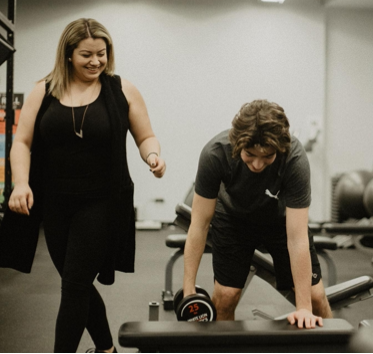The art of accountability.
This is a Guest Article written by Megan Pomarensky…
The art of accountability.
Non-compliance is not a thing.
Let’s get this straight. If a client isn’t following through on a program, it’s your fault. Not the client’s fault.
Your fault.
Let’s back up here, and I’ll explain why.
Behavior Change. That’s really what we’re doing with any sort of training program; whether rehab, prevention, or performance.
Behavior change is the process of changing a habit, over time.
Note the key part of that sentence… “over time”.
It’s a process. Not an event.
So not only is it important to recognize this is going to take time, for any behavior to change, you have to believe that a new habit is going to serve you better. Otherwise, why change?
The other aspect to consider,
is that in order to believe, you have to understand.
Understand what is happening.
Why it’s happening.
How the program/intervention/change will lead to success. What the definition of success actually is.
If you stop reading now, or take nothing else away from this article – these two points about belief and understanding will bring a lot of clarity to why some clients struggle with changing a behavior.
But because it’s fun, let’s dig a little deeper.
Psychology and pain research have shown that there are many methods and processes that can lead to a behavior change. But whether you’re going down the transtheoretical model, behavior change wheel, or any other framework, you’ll find a few similarities.
- Is the goal/changed behavior meaningful? Understood?
- Is the client psychologically and emotionally ready to change?
- Does the client have the skills required for the new behavior?
- Do the client’s psychosocial constructs support the new behavior?
- Who are they around?
- What’s their environment like?
- Has the client succeeded or failed in the past? Or seen others succeed or fail at that same behavior.
All things (above, and more!) considered…it’s easy to see why a behavior change is hard AF.
Ask yourself…if a client wasn’t “accountable” to their program – were they actually set up for success?
If yes, great, keep doing what you’re doing. If not, it’s time for the tangible stuff now.
While “accountability” is taking ownership of actions, the actions are often approached after shit already hit the fan. aka, as a negative reaction.
Therefore, accountability as a whole feels negative.
Since positivity is always better, let’s reframe that sucker. Instead of “improve accountability”, let’s think of it as “build trust and success before the program even starts”.
Cool? Cool.
Let’s do it. Here’s how:
1. Create a clear outcome/goal:
- That you and the client can both clearly define
- That is meaningful
- That can be measured

2. Allow for more success than failure.
- Challenge and struggle are different things. Challenge your clients in whatever way is indicated to hit their goal, but don’t set them up to feel like shit or fail at the exercise/habit/treatment. That never ends up in a good place.
3. Be consistent.
- With everything. Expectations, goal-setting, re-evaluations, check-ins, follow-ups, programming, communication.
- Taking the guess-work out of things means your clients will know what’s up, and you’ll be way less stressed.
All of this sounds straightforward, right?
Wrong.
This is a great example of things being “simple”, but not “easy”. Because again…behaviour change is a slow process.
Think about the last time you tried to do something differently than your “norm”, or if you haven’t lately, try to brush your teeth with your non-dominant hand, or sit cross-legged the opposite way of what you typically do.
It feels awkward and uncomfortable, and you probably had to think about it really hard, despite it being a small thing.
Next, think about what you’re asking of your clients! How big those habits are in comparison….learning a bunch of new exercises, changing nutrition habits, modifying activities/lifestyle, attending a gym/clinic a few times a week, waking up earlier…
No wonder it can be a struggle!
The nature of change is that it’s a hard, uncomfortable process.
The best way you can acknowledge and support that, is by considering everything outside of the actual rehab/training program too. The psychosocial, environmental, and accessibility concerns. The safety of the client – physically (can they go for walks?) and psychologically (if they aren’t receiving positive feedback, reassurance, and support as they do in session).
Alright, so you’re probably thinking “wtf do I do now, Meg?”
Big picture – acknowledge that accountability starts from the top down. Meaning with you.

On the day-to-day scale;
- Focus on providing clear value and benefit, not over-educating and sounding smart
- Validate your client’s past experiences
- Understand your client’s circumstances
- Consider if your client has the outside support needed
- Consistently seek feedback with a regular review/check-in processes
- Set mutually agreed upon expectations
- Guide clients to where they want to get. Don’t drag them to where you think they should be.
And remember,
Accountability is not a checklist or check-ins. It’s earned trust.
How will you create more trust in your gym and clinic?
I’d love to hear! If you want to chat about this (or more!) hit me up through IG or here!
Megan Pomarensky is a Certified Athletic Therapist, a Certified Functional Strength Coach and a Certified Vinyasa Yoga Instructor with a Master’s Degree in Rehabilitation Science.
Over the past 8 years, Megan has built a successful private clinical practice working with clients from professional athletes looking to improve performance to older adults with chronic pain, and everyone in between. Her mission is to empower every client to better understand their body and make informed decisions about their care.
She also helps athletic therapists, trainers and physiotherapists get out of the textbooks, protocols and checklists for better client results.
IG/Twitter @meganpomarensky
www.meganpomarensky.com